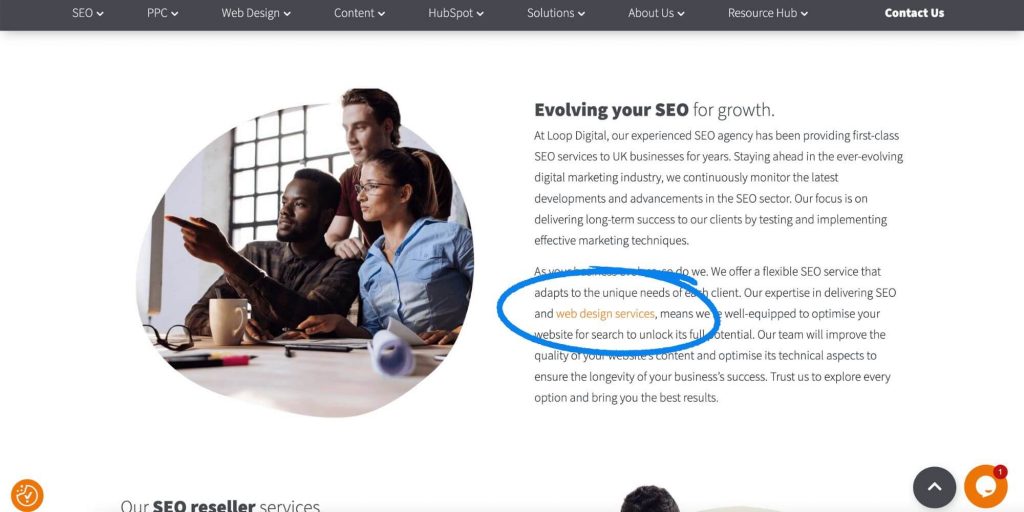Mel is our Partner Strategy & Delivery Manager and also a CIM Chartered Marketer, a testament to her commitment to excellence in the field. But Mel’s contributions don’t stop at the office door. Beyond her professional endeavours, she leads an active life as a qualified run leader and dedicated volunteer. Her experience in these roles has streamlined her leadership and teamwork skills, making her an invaluable asset when it comes to collaborating on projects and ensuring their success. Her sharp insights, strategic thinking, and knowledge have made her a backbone in our team’s ability to drive results for clients in this industry. Mel will make sure that we can approach marketing challenges from all angles and deliver outstanding results for our clients.
Posted on 24/05/2023 by Melanie Comerford
An SEO Guide to Anchor Text Distribution
In the vast landscape of SEO, one of the key factors that can greatly influence your website’s visibility and ranking is anchor text. Often overlooked, anchor text plays a crucial role in signalling to search engines about the content and relevance of the linked page. But it’s not just about using any anchor text; it’s about having the best anchor text distribution.
In this guide, we will delve into the concept of anchor text distribution and explore strategies to optimise it effectively. By understanding the importance of anchor text distribution and implementing best practices, you can enhance your website’s SEO performance and improve its chances of ranking higher in search engine results pages.
What is Anchor Text?
Anchor text refers to the clickable text within a hyperlink. When you create a hyperlink, the anchor text is the visible and clickable part that users interact with. It serves as a bridge between different web pages, directing users to relevant content and providing search engines with valuable context.

Essentially, anchor text serves two different purposes: it helps users understand what they can expect to find when they click on a link, and it also assists search engines in determining the content and relevance of the linked page. Essentially, anchor text acts as a signal to search engines, providing additional information about the linked page’s topic.
Why Anchor Text Distribution Matters
Anchor text distribution plays a crucial role in determining the effectiveness of your SEO efforts. Search engines use anchor text as a signal to understand the content and relevance of the linked page. The way you distribute and optimise your anchor text can have a significant impact on your search engine rankings, visibility, and overall website authority. Let’s explore why anchor text distribution matters and its implications for SEO.
Impact on Search Engine Rankings
Search engines, such as Google, consider anchor text as a valuable ranking factor. When determining the relevance and authority of a webpage, search algorithms analyse the anchor text associated with the links pointing to it. An optimised and well-distributed anchor text profile can positively influence your website’s rankings for targeted keywords and topics.
By strategically incorporating relevant keywords and variations within your anchor text, you can signal to search engines that your content is closely related to those keywords. This can increase the likelihood of your pages appearing higher in search engine results pages when users search for those specific terms.
Impact of Improper Anchor Text Distribution
Improper anchor text distribution can have detrimental effects on your SEO efforts. Over-optimisation, or the excessive use of exact match anchor text, was once a common practice employed to manipulate search engine rankings. However today, search engines have evolved and clamp down on these practices.
Over-optimisation can raise red flags to search engines, indicating unnatural link building or an attempt to manipulate search rankings. This can result in penalties, causing your website to be demoted in search results or even removed from search engine indexes altogether. It goes without saying that nobody wants that.
The Different Types of Anchor Text
Understanding the different types of anchor text is crucial as it allows you to create a well-rounded and balanced distribution strategy. Each type serves a unique purpose and can impact search engine rankings and user experience in different ways. By strategically choosing and diversifying your anchor text, you can enhance the relevance and context of your links, ultimately boosting the effectiveness of your SEO efforts.
Branded Anchor Text
This type of anchor text includes the brand name of the linked website or company. For example, if you’re linking to Nike’s homepage, the anchor text could be “Nike” or “Nike’s official website.”
Exact Match Anchor Text
Exact match anchor text involves using the exact keyword or key phrase that you want the linked page to rank for. For instance, if you’re linking to an article about “digital marketing tips,” the anchor text might be “digital marketing tips.”
Partial Match Anchor Text
Partial match anchor text contains a variation or partial keyword match related to the linked page’s content. It provides a slight variation while still maintaining relevance. For example, if the linked page is about “content marketing strategies,” the anchor text could be “effective content marketing strategies.”
Generic Anchor Text
Generic anchor text uses non-specific phrases like “click here,” “learn more,” or “read this article.” While these phrases are less descriptive, they can still provide context and indicate a call to action.
LSI Anchor Text
LSI (Latent Semantic Indexing) anchor text refers to using related keywords and synonyms that are semantically connected to the linked page’s topic. This type of anchor text helps search engines understand the content better. For example, if the linked page is about “social media marketing,” the LSI anchor text could be “social media advertising” or “social media campaigns.”
If you’re looking for additional support to kickstart or enhance your existing SEO strategy, we’ve got you covered. Our Resource Hub offers a wealth of valuable resources to assist you every step of the way. Visit our Resource Hub now to access these valuable assets and take your SEO efforts to the next level.

Best Practices for Anchor Text Distribution
Achieving an optimal anchor text distribution is crucial for maximising the impact of your SEO efforts. By following these best practices, you can ensure that your anchor text distribution is natural, diverse, and aligned with search engine guidelines. Let’s explore the key strategies for effective anchor text distribution.
1. Conducting Keyword Research
Keyword research forms the foundation of any effective SEO strategy, and it’s no different for anchor text distribution. Identify relevant keywords and phrases that align with your content and target audience’s search intent. By incorporating these keywords naturally into your anchor text, you increase the relevance and context of your links.
Consider using keyword research tools like Google Keyword Planner, SEMrush, or Moz Keyword Explorer to discover relevant keywords and analyse their search volume and competitiveness. This research will help you select appropriate anchor text variations that align with your content and target keywords.
2. Creating a Balanced Anchor Text Profile
Strive for a balanced anchor text profile that includes a variety of anchor text types. Aim for a distribution that includes branded, exact match, partial match, generic, and LSI anchor text. This balanced approach signals to search engines that your link profile is diverse and reflects organic linking patterns.
Avoid overusing exact match anchor text, as it can be seen as a red flag for search engines. Instead, focus on creating a natural blend of anchor text that accurately reflects the content and purpose of the linked pages.
3. Varying Anchor Text Placement
Diversify the placement of your anchor text within your content. Instead of using the same anchor text in every instance, vary its placement across different sections of your webpage. Consider using anchor text in headers, body paragraphs, and call-to-action buttons to distribute the link signals effectively.
Placing anchor text strategically within your content helps search engines understand the relevance of the linked page and improves user experience by providing contextual cues.
4. Ensuring Relevance and Context
Always prioritise relevance and context when selecting anchor text. Link to pages that are directly related to the anchor text and provide valuable information to users. Avoid linking to unrelated or low-quality pages, as it can negatively impact your website’s credibility and search engine rankings.
When choosing anchor text, consider the topic or theme of the linked page and ensure that it aligns seamlessly with the content surrounding it. This approach enhances user experience and establishes a strong connection between your content and the linked resources.
By following these best practices, you can optimise your anchor text distribution for improved SEO performance and user engagement.
SEO Services at Loop Digital
At Loop Digital, we support businesses across the UK to grow their visibility and presence online with our affordable SEO services. Our team of SEO experts are consistently evolving their best practices to ensure we drive maximum impact and return on investment for your business. For more information about how we can support you with local and national SEO campaigns, get in touch with our team today.
Looking for your next opportunity?
Digital marketing careers
We’re always on the lookout for talented individuals to join our ever growing team. If you think you’d be a great match for Loop Digital, we’d love to hear from you.

Join 300+ business owners getting weekly growth strategies - subscribe now.
"*" indicates required fields






